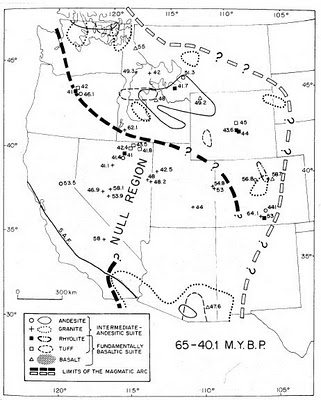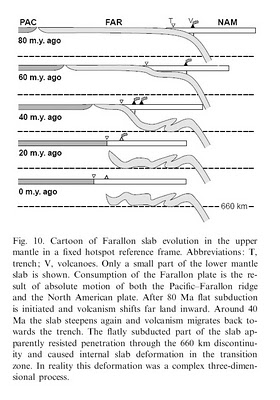20 May 2008
Accretionary Wedge #9: Cenozoic magmatism and the subduction of the Farallon slab
Posted by Jessica Ball
 My significant geological event is a pretty long one – actually, something like 40 million years long, and probably still ongoing somewhere down in the mantle. The subduction of the Farallon plate actually means a great deal to me, because without it, my senior thesis research would never have happened. (Okay, probably a lot of other things, including me being born, wouldn’t have happened, but my research is pretty dependent on it.) Callan talked about the accretionary wedge that formed during the subduction, and how it parallels orogenic activity on the East coast of the US, but I wanted to concentrate on the intraplate effects of Farallon subduction. (And hopefully I won’t screw any of this up – it’s been a while since I wrote this part of my thesis.)
My significant geological event is a pretty long one – actually, something like 40 million years long, and probably still ongoing somewhere down in the mantle. The subduction of the Farallon plate actually means a great deal to me, because without it, my senior thesis research would never have happened. (Okay, probably a lot of other things, including me being born, wouldn’t have happened, but my research is pretty dependent on it.) Callan talked about the accretionary wedge that formed during the subduction, and how it parallels orogenic activity on the East coast of the US, but I wanted to concentrate on the intraplate effects of Farallon subduction. (And hopefully I won’t screw any of this up – it’s been a while since I wrote this part of my thesis.)
(Image from Wannamaker et al., 2003, using seismic tomography to illustrate the current position of the Farallon slab.)
During the Laramide Orogeny, which started between 70 and 80 million years ago, there was a great deal of intraplate magmatism and volcanism in the Western United States. Igneous activity in eastern California, Nevada, and western Utah moved southward along a generally east-west trending front, and magmatic processes were characterized by both extensive calk-alkaline (does anyone still use that term?) and bimodal volcanism, and widespread plutonism beneath south-central and southwestern Utah. After ~20 Ma, the bimodal stuff transitioned to mainly basaltic volcanism resulting from Basin-and-Range extension. The assumption here is that everything before the basaltic volcanism was a result of the subduction of the Farallon plate, and that the patterns of those volcanic rocks reflect the geometry of the subducting plate.
 But the interesting thing about Farallon subduction is that, at the end of the Laramide orogeny (35 to 55 Ma), there was a distinct lack of volcanism over the Farallon plate – even though it was still being subducted (and still is today, somewhere down in the mantle) . Simply put, it “skipped” a large area, mostly under Nevada and part of Utah, and then started up again ~40 Ma (sometimes called the “Mid-Tertiary Ignimbrite Flare-up”).
But the interesting thing about Farallon subduction is that, at the end of the Laramide orogeny (35 to 55 Ma), there was a distinct lack of volcanism over the Farallon plate – even though it was still being subducted (and still is today, somewhere down in the mantle) . Simply put, it “skipped” a large area, mostly under Nevada and part of Utah, and then started up again ~40 Ma (sometimes called the “Mid-Tertiary Ignimbrite Flare-up”).
(Figure from Lipman et al., 1972, of the “skip”, or lack of magmatic activity after ~40 Ma.)
Several models have been suggested to explain this “skip”, and they involve changes in the way the plate was subducting. My background research mostly pulled up ideas focused on the “flat-slab” subduction style, where the Farallon plate is thought to have switched from a steep dive (~30 degrees) into the mantle to a shallow, nearly-horizontal (~5 degrees) movement against the lithosphere. This would effectively shut off the magmatic source for volcanism, accounting for the “skip”. A resurgence in this magmatism resulted from more changes in the subduction geometry; in one model, the downgoing Farallon plate began to steepen again at ~40 Ma, allowing for more decompression melting and magmatism under the western United States; and in another model, only part of the plate steepens (like ripping a part of a sheet of paper in half, keeping one half horizontal and pulling the other down).  This model suggested that the “rip” or warp in the plate propagated south as the plate subducted, which accounts for the patterns of volcanic deposits produced during this interval (moving south and west-to-east at the same time). The second idea also explains the lack of volcanism south of the igneous “front” by having the steeply-dipping portion of the downgoing plate on the north side of the front, and the gently-dipping plate to the south. Since the steep subduction would result in hydration and melting of the mantle wedge and the shallow subduction would not, volcanism would be concentrated above the steeper portion of the Farallon plate.
This model suggested that the “rip” or warp in the plate propagated south as the plate subducted, which accounts for the patterns of volcanic deposits produced during this interval (moving south and west-to-east at the same time). The second idea also explains the lack of volcanism south of the igneous “front” by having the steeply-dipping portion of the downgoing plate on the north side of the front, and the gently-dipping plate to the south. Since the steep subduction would result in hydration and melting of the mantle wedge and the shallow subduction would not, volcanism would be concentrated above the steeper portion of the Farallon plate.
(A “cartoon” of a proposed evolution of the Farallon slab in the upper mantle by Schmid et al., 2002.)
There are, of course, other ideas on Farallon subduction (including one about how a “rift pillow” of hot material built up during the Laramide may be responsible for Basin-and-Range faulting, and another that suggests remnants of the Farallon plate are responsible for driving local mantle flow under the New Madrid Seismic Zone and could be a driving mechanism for seismicity there), and other explanations for why there was so much volcanic activity in an intraplate setting, but I tend to favor the slab-geometry ones – at least for the moment.
Why is all this significant to me? Without the Farallon subduction, the particular patterns of volcanism that produced the High Plateaus of Utah (and associated igneous provinces like the Marysvale Volcanic Field) would not have happened. No High Plateaus = no thesis for Tuff Cookie. It’s also particularly important to me because it ties the geology of a relatively small area into processes that operated over millions of years and across a good chunk of the continent – the kind of comprehensive understanding that’s very difficult to wrap your mind around. When I first visited the High Plateaus as part of my first real field course, I didn’t know a thing about magmatism and tectonics in the Western US. I picked up a little on that trip, but it wasn’t until I returned several years later for my thesis research that I had a chance to really dig (sometimes literally) into the geologic history of the area – and understand it.
I had a moment somewhere in the panic of thesis-writing where it all clicked together, and I could draw connections I’d never considered before. It certainly wasn’t on the scale of an epiphany, but it was exciting – and why else would anyone do geology? It’s one of the reasons that I like to describe geology as puzzle-solving, because at some point in a project I always have one of those “ah-ha” moments where the pieces finally fit together.
Going back and reviewing all that research again is also very enlightening; I’m able to see where my thesis can be improved, and what I can do better when I’m writing on the subject in the future. Learning about the subduction of the Farallon plate not only gave me valuable material for my thesis, it forced me to think on very grand scale – to realize that the repercussions of a single event could last millions of years and have an impact on nearly the entire continent (if you include the New Madrid research). I find it fascinating, and amazing, and
just pretty darn cool.
References:
Forte, A. M., J. X. Mitrovica, R. Moucha, N. A. Simmons, and S. P. Grand (2007), Descent of the ancient Farallon slab drives localized mantle flow below the New Madrid seismic zone, Geophys. Res. Lett., 34, L04308, doi:10.1029/2006GL027895.
Lipman, P.W. et al., 1972, Cenozoic Volcanism and Plate-Tectonic Evolution of the Western United States: Philosophical Transactions of the Royal Society of London. Series A, Mathematical and Physical Sciences, v. 271, no. 1213, p. 217-248.
Schmid, C. et al., 2002, Fate of the Cenozoic Farallon slab from a comparison of kinematic thermal modeling with tomographic images: Earth and Planetary Science Letters, v. 204, p. 17-32.
Stewart, J.H. et al., 1977, East-west patterns of Cenozoic igneous rocks, aeromagnetic anomalies, and mineral deposits, Nevada and Utah: Geological Society of America Bulletin, v. 88, p. 67-77.
Wannamaker, P.E. et al., 2001, Great Basin-Colorado Plateau Transition in Central Utah: An Interface Between Active Extension and Stable Interior: Utah Geological Association Publication 30 – Pacific Section American Association of Petroleum Geologists Publication GB78, 38 p.
Other resources:
USGS diagram of the Farallon plate subduction from 30 Ma to present
Wikipedia article on the Farallon plate
A NASA Scientific Visualization Studio animation of the subduction
One of Tanya Atwater’s (UCSB) animations showing the history of the Western North American plate from 38 Ma to present.


 Jessica Ball is a volcanologist at the U.S. Geological Survey, researching volcanic hydrothermal systems and stability, and doing science communication for the California Volcano Observatory. She previously worked at the Geological Society of America's Washington DC Policy Office, learning about the intersection of Earth science and legislative affairs. Her Mendenhall postdoc and PhD focused on how water affects the stability of volcanoes, and involved both field investigations and numerical modeling applications. Her blogging covers a range of topics, from her experiences in academic geosciences to science outreach and communication to her field and lab work in volcanology.
Jessica Ball is a volcanologist at the U.S. Geological Survey, researching volcanic hydrothermal systems and stability, and doing science communication for the California Volcano Observatory. She previously worked at the Geological Society of America's Washington DC Policy Office, learning about the intersection of Earth science and legislative affairs. Her Mendenhall postdoc and PhD focused on how water affects the stability of volcanoes, and involved both field investigations and numerical modeling applications. Her blogging covers a range of topics, from her experiences in academic geosciences to science outreach and communication to her field and lab work in volcanology.
Pretty impressive.Thank you very much, I enjoyed reading it.
Yay for Cenozoic magmatism, and Yay for Farallon slab subduction!A very informative post, and very nice graphics. Thanks for putting all of this here in one place. Where would we all be without flat subduction? (Well, I might be somewhere in Utah or Colorado?)
Thanks!It’s good practice for me, since I have to get used to serious writing again after my year off. I’m glad I’ve retained some measure of coherency :)Yay flat slab subduction!